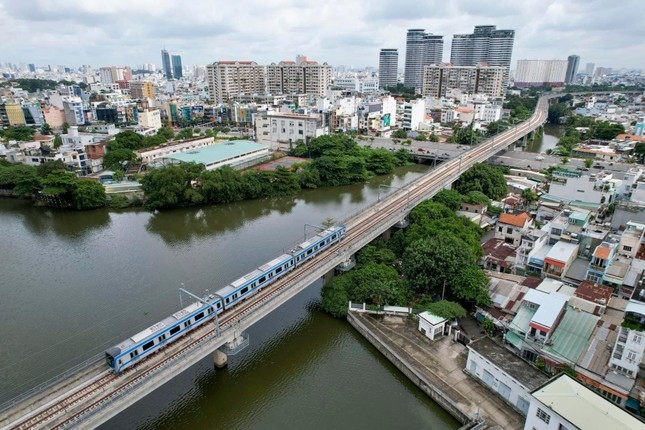The above information was presented by Director of the City Department of Transport Tran Quang Lam in a recent meeting, hosted by Chairman of the City People’s Committee Phan Van Mai, to hear reports on the project to develop the city urban railway system according to Conclusion 49-KL/TW of the Politburo.
 |
| A section of urban railway line No. 1 in Ho Chi Minh City (Ben Thanh - Suoi Tien). Photo: Zings.vn. |
Lam said that the department and related departments, branches and units have developed a metro project, proposed development orientations, built roadmaps, plans and investment forms, and capital mobilization plan. They also discussed specific mechanisms and policies to accelerate investment preparation procedures and invest in developing the urban railway network in the southern city until 2035 and new routes expected to be added to 2040, with a vision to 2060.
Specifically, by 2035, the city will complete construction of about 182.49 km of metro, including lines No. 1, 40.8 km; No. 2, 20.22/62.8 km; No. 3, 29.53/62.17 km; No. 4, 36.82/43.4 km; No. 5, 32.5/53.87 km; and No. 6, 22.85/53.8km.
By 2045, the hub will have an additional 168.36 km, complete the rest of lines 2,3,4,5, and 6 and implement line 7.
By 2060, HCM City will build metro lines 8, 9, 10, thereby increasing the total length of the city's urban railway system to about 510.02 km.
The total expected investment for the 10 metro lines in the city is more than 824 trillion VND (about 34.39 billion USD).
At the meeting, in addition to opinions of departments and agencies, experts said that the problem of capital is a key issue for the southern hub to achieve its goal of completing the urban railway system as proposed. From there, HCM City needs to clarify investment forms, capital source plans, capital mobilization and new breakthrough mechanisms and new specific policies.
According to Chairman Phan Van Mai, the project to develop HCM City’s urban railway system concretizes the implementation of Conclusion No. 49 of the Politburo. This is also an important tool for the city to restructure urban areas, develop a multi-center urban model, and distribute population in accordance with socio-economic activities with a megacity like HCM City./.